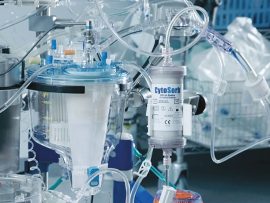Abstract Introduction Extracorporeal cardiopulmonary resuscitation (eCPR) is a rescue therapy for refractory cardiac arrest, with evidence suggesting improved outcomes when performed at experienced centres. Unlike conventional CPR (cCPR), eCPR patients..
Read MoreAbstract Cardiac surgery is a commonly performed procedure worldwide, with an estimated 1–1.5 million cases per year and figures destined to increase in the next few years []. A significant..
Read MoreAbstract Implantations of (VADs) have significantly improved and life expectancy of end-stage heart failure patients. However, despite the advancements in the VAD designs and patient management protocols, the VAD recipients remain at..
Read MoreAbstract Cardiac surgery-associated acute kidney injury (CSA-AKI) is a common complication following cardiac surgery. Despite growing awareness of sexual dimorphism in cardiovascular and chronic kidney disease, little is known about..
Read MoreAbstract Venoarterial extracorporeal membrane oxygenation (VA-ECMO) serves as a critical mechanical circulatory support modality, sustaining systemic circulation in cases of severe cardiac failure or cardiac arrest. While VA-ECMO improves hemodynamics,..
Read MoreAbstract Background The safety and efficacy of prophylactic corticosteroid administration during the perioperative period of cardiac surgery have undergone extensive and comprehensive examination. In this study, we conducted a bibliometric..
Read MoreAbstract Purpose of review After more than 50 years from its invention, the intra-aortic balloon pump (IABP) is still one of the most widely used mechanical circulatory support devices to..
Read MoreAbstract Importance Studies suggest that everolimus may reduce the risk of rejection, cardiac allograft vasculopathy (CAV), chronic kidney disease (CKD), and cytomegalovirus (CMV) after heart transplant. Everolimus use is controversial because..
Read MoreAbstract Nutritional support in pediatric patients receiving extracorporeal membrane oxygenation (ECMO) therapy is controversial. Although ECMO is increasingly used in pediatric intensive care units, there is no consensus on the..
Read MoreAbstract Background Intraoperative hypotension (IOH), defined as a mean arterial pressure (MAP) below 65 mmHg, is a common complication during surgery and is associated with significant postoperative morbidity, including acute..
Read MoreAbstract Veno-arterial extracorporeal membrane oxygenation (ECMO) brings many monitoring pitfalls due to the countercurrent blood flow, which may create left ventricular overload and perfusion imbalances between the two cerebral hemispheres...
Read MoreAbstract Background Prior clinical research demonstrated that rapid reduction in arterial carbon dioxide (PaCO2) levels during extracorporeal membrane oxygenation (ECMO) is associated with acute brain injury (ABI), which may be..
Read MoreAbstract Background Cardiac surgery-associated acute kidney injury (CSA-AKI) is a notably common complication in pediatrics, with an incidence rate ranging from 15 to 64%. This rate is significantly higher than..
Read MoreAbstract Despite advancements in care, out-of-hospital cardiac arrest has a low survival rate. Extracorporeal cardiopulmonary resuscitation (ECPR) has shown improved outcomes in select cases, notably in the ARREST trial. However,..
Read MoreAbstract Background: The growing popularity of extracorporeal membrane oxygenation (ECMO) necessitates adequate education and training of the multidisciplinary teams caring for these medically complex patients. Simulation-based education (SBE) has been used..
Read MoreAbstract Background: End-stage heart failure remains a major global health challenge with high mortality. While heart transplantation is the gold-standard treatment, the scarcity of donor hearts necessitates alternative therapies. Left..
Read MoreAbstract Background Heparin-induced thrombocytopenia (HIT) is an immune-mediated platelet disorder caused by antibodies that target complexes of platelet factor 4 (PF4) and heparin. HIT has been characterized as a polyclonal..
Read MoreAbstract This meta-analysis aimed to compare short-term outcomes in patients undergoing minimally invasive cardiac surgery (MICS) using endoaortic balloon (EAB) and transthoracic aortic clamp (TAC) techniques. A comprehensive search of..
Read MoreAbstract The need for organs suitable for transplantation has continued to rise as need outweighs availability. Increased demand has driven innovation in the field. Over the past ten years, donation..
Read MoreAbstract BACKGROUND: Large language models (LLMs) are increasingly used in the medical field and have the potential to reduce workload and improve treatment procedures in clinical practice. This study evaluates..
Read MoreAbstract Purpose The optimal ventilation strategy in acute respiratory distress syndrome (ARDS) patients with veno-venous extracorporeal membrane oxygenation (VV-ECMO) remains unknown. We aimed to compare the effects of two ultra-protective..
Read MoreAbstract Uncertainties in norepinephrine dose reporting due to variable labeling practices secondary to salt formulation considerations have resulted in significant clinical and research challenges, potentially leading to impaired comparability across..
Read MoreAbstract Introduction Bleeding and thrombosis are major causes of morbidity and mortality in pediatric extracorporeal membrane oxygenation (ECMO), yet their evolving, time-dependent risks remain poorly defined. This study evaluated clinical..
Read MoreAbstract Background - Postoperative hemorrhage is a significant complication of cardiovascular surgery. Although autologous cell salvage is safe and effective for preserving patients' blood, its use in the postoperative context remains..
Read MoreAbstract Background (SCI) is a devastating complication of open descending thoracic (DTAA) and (TAAA). We evaluated the efficacy of spinal drain placement on spinal injury in DTAA/TAAA repair. Methods Adult patients..
Read MoreAbstract Background Development of Physiological Science (PS) Networks in the United Kingdom is guided by a 2023 strategic framework aimed at enhancing diagnostic services and patient care through collaboration and..
Read MoreAbstract Extubation of select neonatal and pediatric patients supported with extracorporeal membrane oxygenation (ECMO) may avoid ventilator-induced lung injury, decrease neurosedative exposure, and improve rehabilitation. A single-center retrospective cohort study..
Read MoreAbstract Background: Sepsis and septic shock are major contributors to global morbidity and mortality. The “cytokine storm,” a hyper-inflammatory response, plays a central role in sepsis pathophysiology, leading to multi-organ..
Read MoreAbstract Background The use of extracorporeal life support (ECLS) has expanded to include unique populations such as peripartum women. This systematic review aims to (1) quantify the number of cases..
Read MoreAt the time of publication of this guideline, the leading causes of maternal death for pregnant and peripartum patients include hemorrhage, infection, eclampsia, thromboembolism, and cardiac disease. Not only are these..
Read More




















